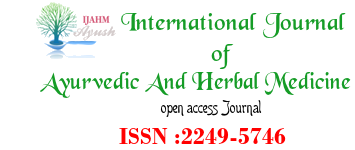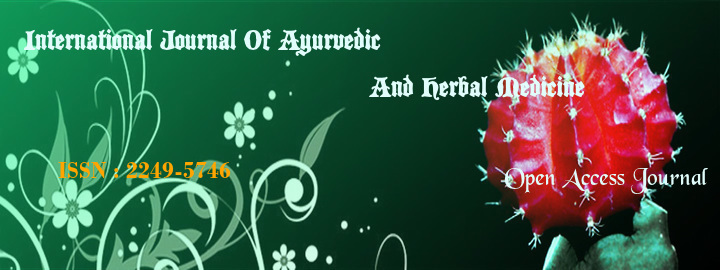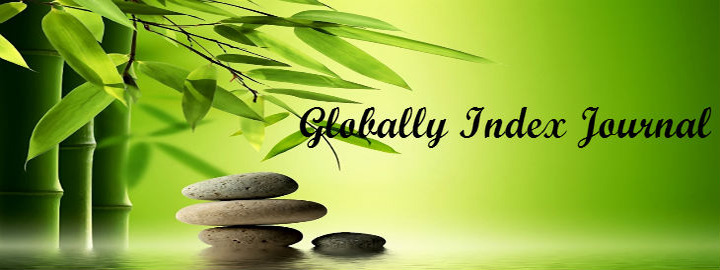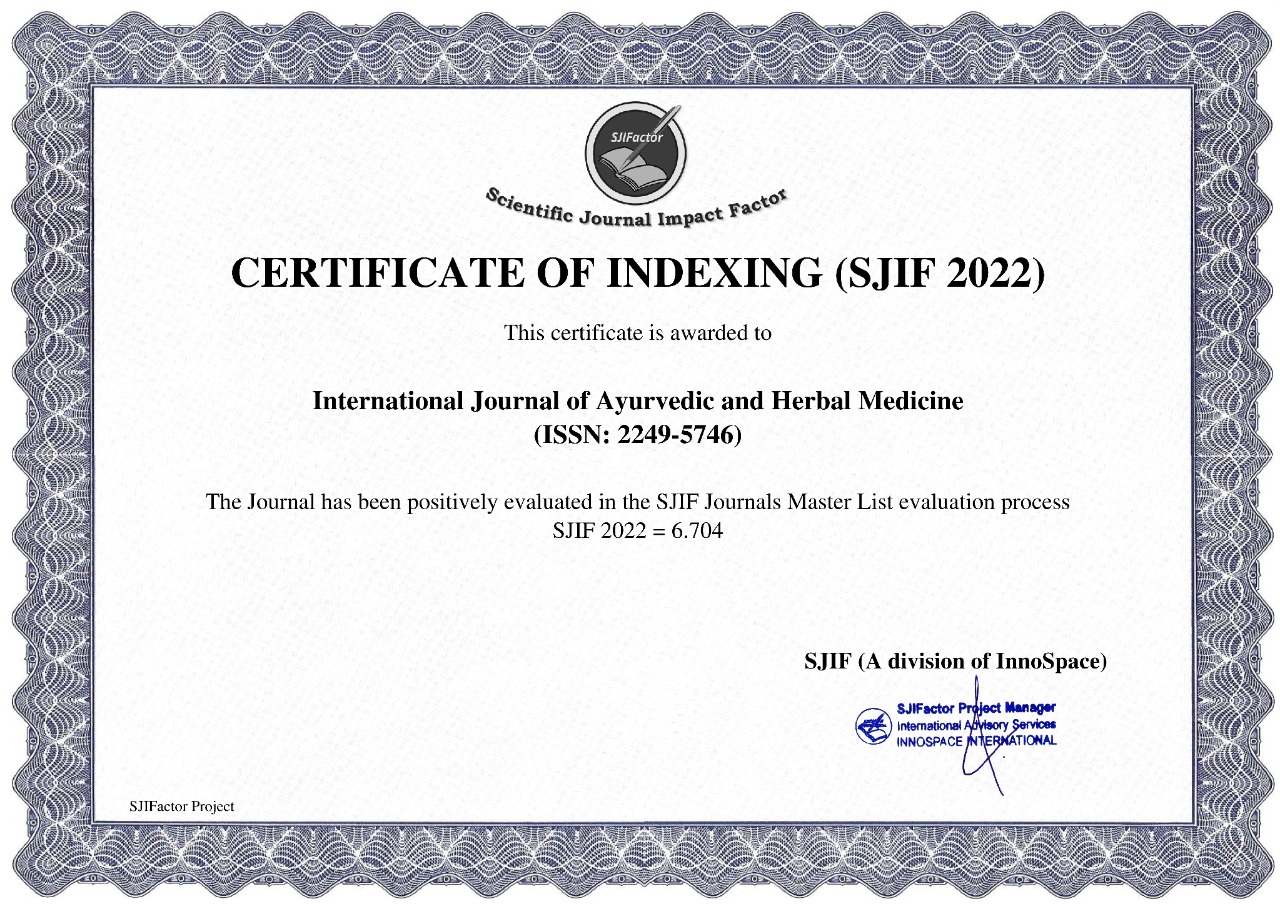


1Dr.P.Sudhakar Reddy, 2Dr Beena MD
1Professor and HOD, Dept .of PG Studies in Swasthavritta, JSS Ayurveda Medical College, Mysuru
2Assistant Professor, Dept .of Kayachikitsa , JSS Ayurveda Medical College, Mysuru
Abstract:-
Ayurveda, the science of life which deals with the good , bad , happy and unhappy life , its promoters, non-promoters and the measurements pertaining to the same. The aim of Ayurveda is to maintain health of a healthy individual and curing the disease on an ill person. To achieve the first aim, Ayurveda defined Healthy individual as the person whose dosas, dhatus and malas are in state of equilibrium along with mental, sensory and spiritual pleasantness and happiness. The health of the person determined by so many factors which starts from conception, in this article systematic review has been done to collect the information regarding factors which determine the health of the individual as per Ayurvedic perspective.
Key words: Health, Agni, Prakriti, Ahara , desa
REFERENCES
1. Park K, Preventive and social medicine, 24 th edition, banaridas bhanot2017, p18
2. Acharya JT, Caraka Samhita with Ayurveds dipika commentary of Cakrapani data , Reprint ed. Varanasi (India): Chaukamba Orientalia , 2007. P.512
3. Murthy KRS, Caraka Samhiya , English translation , Volume I, Reprinted. Varanasi , Chaukambha Orientalia , 2010. P.197
4. Murthy KRS, Caraka Samhiya , English translation , Volume I, Reprinted. Varanasi , Chaukambha Orientalia , 2010. P.421
5. 5.Ghanekar BG, Susruta samhita , Hindi translation , Reprinted , New Delhi, Motilal Banarasidas, 1995,p.313
6. Ghanekar BG, Susruta samhita , Hindi translation , Reprinted , New Delhi, Motilal Banarasidas, 1995,p.315
7. Murthy KRS, Caraka Samhiya , English translation , Volume I, Reprinted. Varanasi , Chaukambha Orientalia , 2010. P.127, 132
8. Murthy KRS, Caraka Samhiya , English translation , Volume I, Reprinted. Varanasi , Chaukambha Orientalia , 2010. P.132
9. Acharya YT, Caraka Samhita with Ayurveds dipika commentary of Cakrapani data , 4TH edition Varanasi (India): Chaukamba sanskrit samsthan , 1997,p.276
10. Sharma RK,Dash Dhabavan , carakasamhita with Ayurveds dipika commentary of Cakrapani data, reprint 2008, vol II, Chaukambha Sanskrit Series Office, Varanasi ,2008, P.278
11. Gupta Atridev, Ashtanga hridayam, vidyodini teeka, Chaukambha Sanskrit Series Office, Varanasi 1995, p.10
12. Sharma RK,Dash Dhabavan , carakasamhita with Ayurveds dipika commentary of Cakrapani data, reprint 2008, vol II, Chaukambha Sanskrit Series Office, Varanasi ,2008, P.277
13. Sharma RK,Dash Dhabavan , carakasamhita with Ayurveds dipika commentary of Cakrapani data, reprint 2008, vol II, Chaukambha Sanskrit Series Office, Varanasi ,2008, P.27
14. Bhushan P, Kalpana J, Arvind C. Classification of human population based on HLA gene polymorphism and the concept of Prakriti in Ayurveda. J Altern Complement Med (2005) 11(2):349–536
15. Prasher B, Negi S, Aggarwal S, Mandal AK, Sethi TP, Deshmukh SR, et al. Whole genome expression and biochemical correlates of extreme constitutional types defined in ayurveda. J Transl Med (2008) 6:48.10.1186/1479-5876-6-48
16. Mukerji M, Prasher B. Ayurgenomics: a new approach in personalized and preventive medicine. Sci Cult. New Delhi, India: Institute of Genomics and Integrative Biology; (2011) 77(1–2):10–7.
17. Ghodke Y, Joshi K, Patwardhan B. Traditional medicine to modern pharmacogenomics: ayurveda prakriti type and CYP2C19 gene polymorphism associated with the metabolic variability. Evid Based Complement Alternat Med (2011) 2011:249528.10.1093/ecam/nep206
18. Aggarwal S, Negi S, Jha P, Singh PK, Stobdan T, Pasha MA, et al. EGLN1 involvement in high-altitude adaptation revealed through genetic analysis of extreme constitution types defined in ayurveda. Proc Natl Acad Sci U S A (2010) 107(44):18961–6.10.1073/pnas.1006108107
19. Aggarwal S, Negi S, Jha P, Singh PK, Stobdan T, Pasha MA, et al. EGLN1 involvement in high-altitude adaptation revealed through genetic analysis of extreme constitution types defined in ayurveda. Proc Natl Acad Sci U S A (2010) 107(44):18961–6.10.1073/pnas.1006108107
20. Rotti H, Raval R, Anchan S, Bellampalli R, Bhale S, Bharadwaj R, et al. Determinants of prakriti, the human constitution types of Indian traditional medicine and its correlation with contemporary science. J Ayurveda Integr Med (2014) 5(3):167–75.10.4103/0975-9476.140478
index






















